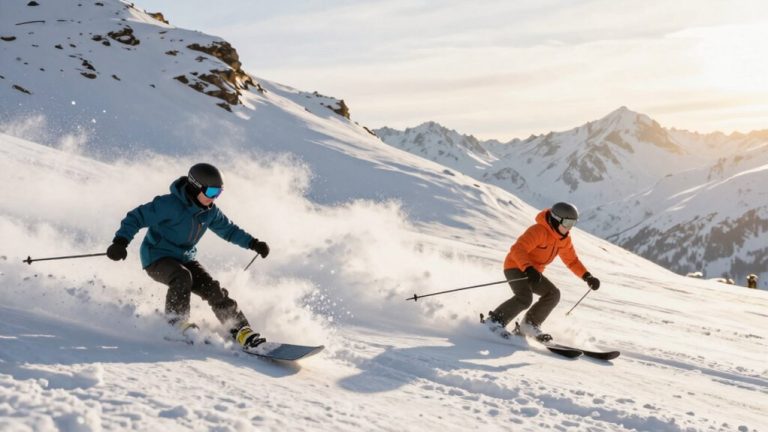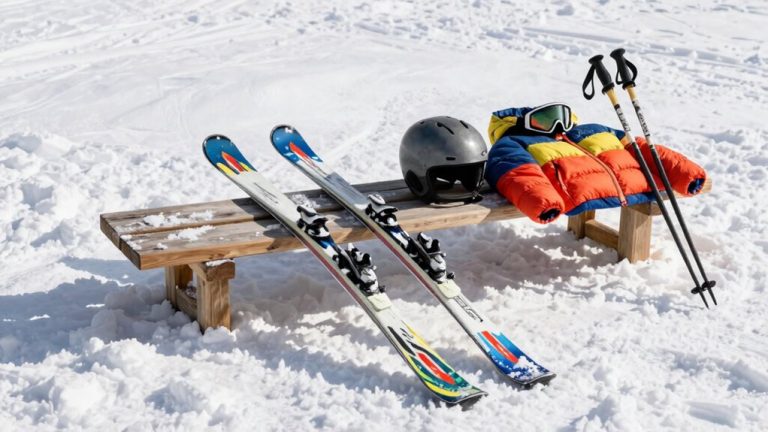General Rules of Ice Climbing
When ice climbing, prioritize safety: choose the right gear wisely for durability. Assess the ice conditions thoroughly before you climb. Guarantee all safety checks are meticulously completed. Master climbing techniques for stability and power. Communicate effectively with your climbing partners. Be vigilant and prepared for weather challenges. Equip yourself with emergency preparedness knowledge. Adhere to Leave No Trace principles for environmental responsibility. Finally, building emergency shelters is essential for survival. Your ice climbing journey is safest when you follow these general rules.
Proper Gear Selection
When preparing for ice climbing, it is important to choose the appropriate equipment to guarantee your safety and success on the ice. Proper gear maintenance and equipment care are vital aspects of ice climbing. Ensuring your gear is in top condition can make a significant difference in your overall climbing experience.
Start by regularly inspecting your ice climbing gear for any signs of wear and tear. Check your crampons for any dull points or damaged parts that may affect your traction. Inspect your ice tools for any cracks or loose components that could compromise their performance. It is also important to examine your harness, ropes, and helmet for any damage that could jeopardize your safety.
Proper care and maintenance of your ice climbing equipment not only enhance its longevity but also contribute to your safety on the ice. Develop a routine for cleaning and storing your gear after each use to prevent corrosion and damage. By investing time in gear maintenance, you are investing in your safety and success as an ice climber.
Assessing Ice Conditions
Before you step onto the ice, it's vital to assess the conditions thoroughly. Understanding ice thickness and utilizing visual inspection techniques are essential for your safety. By being observant and knowledgeable about ice conditions, you can make informed decisions while ice climbing.
Ice Thickness Assessment
Evaluating ice conditions demands a keen eye for detail and a thorough understanding of how to determine ice thickness accurately. Ice thickness is a critical factor in ice climbing safety. Before venturing onto a frozen wall, make sure your equipment is in top condition to handle the challenges ahead. Proper equipment maintenance is essential for your safety. Understanding ice climbing grades and effective route planning will help you anticipate potential hazards and plan accordingly. Evaluating ice thickness involves tapping the ice with a tool to listen for a hollow sound, visually inspecting for cracks or discoloration, and observing the overall quality of the ice. Remember, risk management is key; never underestimate the importance of accurate ice thickness evaluation before attempting a climb.
Visual Inspection Techniques
To evaluate ice conditions effectively, employ a systematic visual inspection technique that includes tapping the ice, examining for cracks, and gauging overall quality. Vital identification and risk assessment are essential steps in ensuring your safety while ice climbing. Look for areas where the ice may be thin or weakened, such as near flowing water or areas exposed to direct sunlight. Check for any visible cracks or fractures that could indicate instability. Assess the overall quality of the ice by observing its color and texture. Remember, thorough visual inspection is key to making informed decisions about anchor building and belay techniques. By honing your ability to assess ice conditions visually, you empower yourself with the knowledge needed to navigate ice climbing challenges safely.
Safety Checks and Protocols
Before gearing up for ice climbing, make sure to conduct a thorough gear inspection and familiarize yourself with communication signals. These safety checks and protocols are crucial for a successful and secure ice climbing experience. Remember to prioritize safety above all else to fully enjoy your adventure.
Gear Inspection
Inspect your equipment thoroughly before setting out on an ice climbing expedition to guarantee your safety and preparedness for the challenges ahead. Examining gear is essential; make sure your ice tools are sharp, with secure wrist straps, and that your crampons are properly fitted and in good condition. Check your harness for any signs of wear and tear, confirming all buckles and straps are functioning correctly. Examine your helmet for cracks and ensure a snug fit. Verify that your ropes are free from frays or damage. Assess your clothing layers for warmth and mobility. Safety first – by carefully checking your gear, you are taking the necessary steps to mitigate risks and enjoy a successful ice climbing adventure.
Communication Signals
Before embarking on your ice climbing adventure, ensuring clear communication signals through safety checks and protocols is vital for a successful and safe climb. Non-verbal cues and hand signals play a pivotal role in ice climbing, allowing climbers to communicate efficiently without the need for verbal exchanges. Establishing a signal protocol with your team is essential for seamless coordination during the ascent. Prioritize practicing these signals with your climbing partners to ensure everyone understands and responds appropriately. Consistent use of these communication methods can prevent misunderstandings, enhance teamwork, and ultimately contribute to a more enjoyable climbing experience. Remember, effective communication is key to overcoming challenges and staying safe in the unpredictable environment of ice climbing.
Climbing Techniques and Movements
To improve your ice climbing skills, mastering specific climbing techniques and movements is essential. Balance techniques play an important role in ice climbing, helping you distribute your weight effectively on the ice. Keep your body close to the ice wall, aligning your hips with your feet to maintain balance. Utilize your core strength to stabilize your body as you move upward. When it comes to foot placements, aim for secure positions on the ice. Look for spots where your crampons can grip firmly, ensuring stability with each step. Small, controlled movements are key to conserving energy and maintaining control on the ice.
Practice different foot placements to adapt to varying ice conditions, such as using the front points of your crampons on steeper sections and utilizing the edges for better grip on more vertical surfaces. By honing your balance techniques and perfecting your foot placements, you'll become a more efficient and confident ice climber. Remember, mastering these fundamental movements is the foundation for tackling more challenging ice climbing routes.
Communication With Partners
Utilize effective communication techniques with your climbing partners to guarantee a safe and coordinated ascent on the ice. Team dynamics play an important role in ensuring a successful ice climbing experience. Establish clear signals and codes beforehand to communicate efficiently while on the ice. Non-verbal cues like hand signals or rope tugs can convey important messages when verbal communication is challenging due to distance or noise. Trust building is essential in ice climbing, as you rely on your partners for safety and support. Take the time to get to know each other's strengths, weaknesses, and communication styles to enhance teamwork. Conflict resolution skills are equally essential when tensions arise in high-stress situations. Address any issues openly and respectfully, focusing on finding solutions that benefit the entire team. Remember, effective communication is the key to overcoming obstacles and achieving your ice climbing goals safely and successfully.
Managing Weather Challenges
When facing inclement weather conditions while ice climbing, being prepared and adaptable is vital for a successful ascent. Layering strategies are pivotal in managing the cold temperatures you may encounter. Start with a moisture-wicking base layer to keep sweat away from your skin, add an insulating layer for warmth, and finish with a windproof outer layer to shield you from harsh winds. Windproof clothing can make a significant difference in maintaining your body heat and protecting you from wind chill.
In addition to proper layering, knowing how to build emergency shelters and possessing strong navigation skills are essential for weather challenges. In the event of unexpected storms or sudden drops in temperature, being able to construct a shelter using available materials can mean the difference between life and death. Navigation skills will help you find your way in low visibility conditions or if you need to retreat due to worsening weather conditions. Stay vigilant, keep an eye on the weather forecast, and always prioritize safety when dealing with weather challenges while ice climbing.
Emergency Preparedness
Prepare yourself for any potential emergencies that may arise during your ice climbing expedition by implementing a thorough emergency preparedness plan. When venturing into the icy wilderness, it is essential to equip yourself with essential first aid knowledge and survival skills. Being prepared can make a significant difference in critical situations.
First aid training is invaluable in emergencies such as injuries from falls or frostbite. Carry a well-stocked first aid kit and know how to use its contents effectively. Additionally, understanding basic survival skills like building a snow shelter, starting a fire in wet conditions, and signaling for help can be lifesaving.
Always inform someone trustworthy about your climbing plans and expected return time. This guarantees that if you do not return as scheduled, help can be sent promptly. Familiarize yourself with the emergency contact numbers in the area you are climbing and have them readily accessible.
Leave No Trace Principles
Equip yourself with the Leave No Trace Principles to minimize your impact on the environment while ice climbing. By following these guidelines, you can guarantee responsible climbing practices and help preserve the natural beauty of the ice climbing areas for future generations. Here are three key principles to keep in mind:
- Pack it in, pack it out: Take all your waste with you, including food scraps, toilet paper, and any other trash. Leaving nothing behind helps maintain the pristine environment for others to enjoy.
- Stay on designated trails: Stick to established paths to avoid trampling on fragile vegetation and disturbing wildlife habitats. By respecting the designated routes, you can reduce your environmental impact.
- Minimize campfire impacts: If you need to build a fire, use existing fire rings whenever possible. Keep fires small and ensure they are completely extinguished before leaving. This practice helps prevent damage to the surrounding landscape and reduces the risk of wildfires.
Frequently Asked Questions
How Can I Prevent Frostbite While Ice Climbing?
To prevent frostbite while ice climbing, layer up like you're preparing for the coldest Arctic blast. Choose quality gear, pack hand and foot warmers, hydrate well, and keep blood flowing. Safety first, adventurer!
Are There Any Specific Training Exercises I Can Do to Improve My Ice Climbing Skills?
To enhance your ice climbing skills, focus on strength training for better endurance. Incorporate technique drills and footwork practice into your routine. Developing these areas will elevate your climbing abilities, making you a more proficient climber.
What Should I Do if I Encounter Wildlife While Ice Climbing?
When encountering wildlife while ice climbing, it is crucial to remain calm, evaluate the situation, and give animals space. Guarantee safety by avoiding abrupt movements and loud noises. Remember, honor their habitat and observe from a distance.
How Do I Properly Store and Care for My Ice Climbing Gear?
To properly care for your ice climbing gear, guarantee proper storage, regular maintenance, and organization. These steps not only extend equipment longevity but also demonstrate climber responsibility. Follow care tips to keep gear in top condition.
What Are Some Common Mistakes to Avoid While Ice Climbing?
When ice climbing, avoid common mistakes by prioritizing equipment maintenance and safety precautions. Focus on proper technique, mental preparation, and staying attentive. Keep your gear in top shape, and always be mindful of your surroundings.






